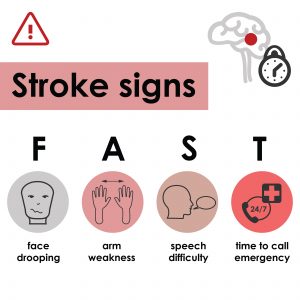May is National Stroke Awareness Month. Every year, the National Stroke Association strives to provide information and to educate the public.
National Stroke Awareness Month was created in 1989 through a combined effort from the United States government, the American Stroke Association, the American Heart Association, the National Stroke Association and other non-profits to raise public awareness about the warning signs of stroke, how to prevent a stroke, and the impact a stroke has on the individual, families and caregivers.
This year, the National Stroke Association’s goals are to help reduce stroke risk factors, and to take people step-by-step through what happens when someone experiences a stroke.
It also highlights the importance of knowing the signs and symptoms of stroke and encourages persons to act FAST (Face drooping, Arm weakness, Speech difficulty, Time to call 9–1–1) if you believe someone is having a stroke.
What Is A Stroke?
A stroke (sometimes called a brain attack) occurs when a blockage stops blood flow to a certain area in the brain, or when a blood vessel in or around the brain bursts. Since oxygen is cut off from brain cells, they begin to die and the ability to control muscles and memory is lost. Depending on where the stroke occurs in the brain determines the severity of the problems to follow. And while some people recover completely recover from strokes, many survivors of stroke will be left some type of disability.
Strokes often lead to serious, life-changing complications that include:
- Paralysis or weakness on one side of the body.
- Problems with thinking, awareness, attention, learning, judgment, and memory.
- Problems understanding or forming speech.
- Difficulty controlling or expressing emotions.
- Numbness or strange sensations.
- Pain in the hands and feet.
- Depression.
Educating Ourselves About Strokes
Nearly 800,000 people in the U.S. experience a stroke each year, and someone dies from stroke every four minutes. Knowing the signs of stroke, how to prevent it, and how to help others around you, just might save a life.
This year the National Stroke Association is turning the spotlight on the risk factors that account for 90% of strokes globally. However, by following these tips and making the necessary lifestyle modifications, you can greatly reduce your chances of having a stroke:
- Controlling Hypertension: Hypertension remains the single most important modifiable risk factor, accounting for nearly 48% of strokes. Getting your blood pressure checked is an important first step in controlling your stroke risk.
- Maintaining A Healthy Diet: What we eat has an impact on our overall health. Eating a diet that is high in fat, sugars, and sodium puts your parent at a higher risk for a stroke. Start by swapping foods that are high in fat for ones that are low-fat and swap high-fat dairy for low-fat versions, such as replacing whole milk with skim milk.
- Staying Active With Exercise: Research has shown that unhealthy behaviors such as physical inactivity and poor diet increase your stroke risk, so it’s important incorporate physical activity into each day. Walking is an excellent form of exercise for seniors, and just walking for 20 or 30 minutes per day is encouraged.
- Stop Smoking: If your parent smokes, they need to quit. People who smoke are at double the risk for a stroke compared to those who do not smoke. Quitting smoking can be very difficult, but a doctor can help.
- Reduce Alcohol Consumption: Cutting back to just one or two drinks per day can reduce the risk for stroke. Alcohol causes the blood pressure to rise, which increases the chances for a stroke.
SIGNS AND SYMPTOMS OF STROKE
Knowing the signs and symptoms of a stroke are equally important. Someone in the U.S. has a stroke every 40 seconds.
When responding to a stroke, every minute counts. The sooner a patient receives medical treatment, the lower the risk for death or disability. Here are some signs and symptoms to look out for:
- Numbness or weakness of the face, arm, or leg, especially on one side of the body.
- Confusion, trouble speaking, or difficulty understanding.
- Trouble seeing in one or both eyes.
- Trouble walking, dizziness, or loss of balance and coordination.
- Severe headache with no known cause.
The acronym FAST is the best way to identify the most common symptoms of a stroke:
F – Face: Ask the person to smile. Does one side of the face droop?
A – Arms: Ask the person to raise both arms. Does one arm drift downward?
S – Speech: Ask the person to repeat a simple sentence. Is their speech slurred?
T – Time: If you observe any of these signs, call 9-1-1 immediately.
A common misconception is that strokes occur only in older adults. Although, your stroke risk increases with age, a stroke can happen to anyone at any time.
Additionally, it is important to keep in mind that not all individuals will display all the above warning signs. However, if you suspect your loved one could be suffering a stroke, it’s better to seek treatment regardless.
Ways To Support National Stroke Awareness Month:
- Post on Twitter and/or Facebook to get the word out.
- Visit stroke.org/nsam for more ideas on how you can get involved and spread the word about National Stroke Awareness Month.
The National Stroke Association (www.stroke.org) offers resources, information and support for stroke patients and family caregivers. Visit their website for more information about this year’s National Stroke Awareness Month.





